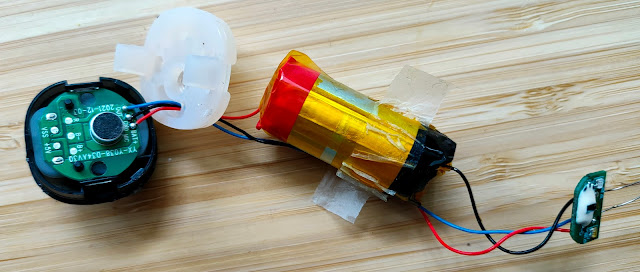I seem to be inadvertently gaining a new hobby. A short cycle ride last week yielded 3 more 'disposable' e-cigs.
DANGER:
This time, two ENG Legends and a more substantial R and M Tornado. The latter had a USB-C connector and although I couldn't see a way to refill it with fluid, looked like a reusable model. This turned up some interesting clues, as you will see later.
First, the ENG model. This is very similar to the models I took apart in my previous post.
Again, it's much the same arrangement with a thing looking for all the world like an electret mic insert switching the battery to the heating element. It has a nice useable 5.5Wh battery -- again without any protection PCB.
The insides of the R and M Tornado are altogether much more interesting.
Not only does this board have a little PCB holding a LiPo charging circuit and USB-C socket, but also the PCB is nicely designed and silkscreen labels for the parts and terminals. A second PCB for the heating element has what I assume to be a SOT-23 MOSFET. The heater PCB receives power from the battery and a control signal from the first PCB,
This PCB has the USB socket and LiPo charging on one side.
The other side has a microphone that supplies the control signal to turn the heating element on.
This PCB is a handy little charging circuit. There is no obligation to use the 'puff sensing' feature. With the addition of a switch and a CREE LED bulb, you could make a great little USB torch. Maybe something for the next blog post.







No comments:
Post a Comment